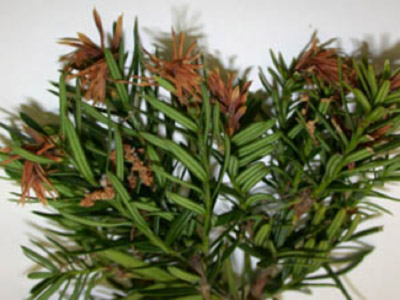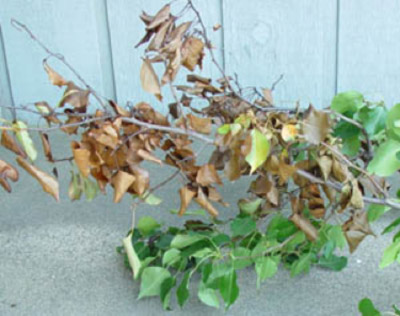Issue 1, April 16, 2012
Widespread Frost Injury to Trees and Woody Ornamental Leaves
The freezing night temperatures this past week took a toll on the leaves of woody ornamentals and tree that were still in the early process of leafing out. Frost injury occurs when ice crystals form within the plant cells and rupture the cells. This produces a water soaked appearance to the tissue. In other words, the leaf will look like it was smashed, which essentially is what happens when the cells burst. Succulent shoots may appear blackened.

Yew with frost injury to succulent growth.
Some of the reported species damaged by frost include: catalpa, black walnut, golden rain tree, Japanese pagoda, hackberry, gingko, hydrangeas, fringe tree, magnolia, viburnums, mulberry, ash and the list marches on. Tree and shrub leaves that were not still in the process of succulent growth were not as dramatically affected.
These symptoms are notably similar to disease symptoms you might see from bacterial diseases such as fire blight Erwinia amylovora, or bacterial blight Pseudomonas syringae. The difference will be in the sheer quantity of damage and species affected. Frost injury will directly follow a frost/freeze event and will typically uniformly affect all the leaves. Whereas, the two bacterial diseases will develop over time and affect individual branches. Frost is not selective. It affects any of the deciduous plants in the same type of site exposure. For instance, if the viburnum in your front yard is frosted, other nearby deciduous plants should also show some leaf, bud, or stem injury. Look specifically at plants that are not hosts of fire blight. Fire blight affects only plants in the rose family. Finally, cut into some stem tissue to determine whether only leaves are affected (more typical of frost) or stem tissue is discolored (more typical of fire blight).

Fire blight symptoms on pear, note that not all leaves are affected.
Bottom line: What will this mean for these frosted and freeze damaged species? Although the trees and shrubs look pretty bad to you now, the best recommendation is to just ‘wait’. Trees and shrubs that were in good health prior to the damage should begin to re-leaf in about 3 weeks. That’s a long time to wait in the spring but your patience will be rewarded. (Suzanne Bissonnette)
Author:
Suzanne Bissonnette